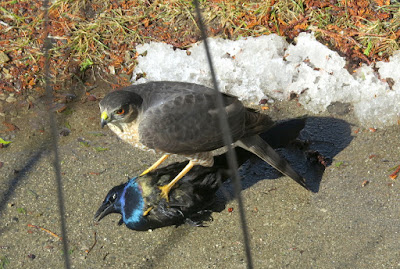 |
| A record high! |
Participants: 40.
Weather: Temps: -5.3º C to 0.3º C. Wind: NW, 27.4 km/h to 59.5 km/h. Mixed sun and clouds. No precipitation. [Data from Bill Caulfeild-Browne's Tobermory weather station, thanks Bill!]
Total Species: 41 (average=40). Additional Count Week species seen (so far) include: Green-winged Teal, one near Cape Hurd.
Total individuals: 1108 (average=1646).
 |
| Counting forest birds at Emmett Lake, BPNP. Photo: Martha Allen. |
Noteworthy Highs, Lows and Misses:
Wild Turkey: 29. Record high. Wild Turkey was first detected on the Tobermory count in 2008 and the growing numbers on the Peninsula reflect an ongoing increase throughout the Great Lakes area over the past decade.
Eastern Screech-Owl: 4. Tied for the second highest count (four were also detected in 2012). In 2013, seven were recorded (average=0.7).
Red-breasted Nuthatch: 155. A record high (average=41).
Common Raven: 13. Lowest count since 1975 when six were recorded (average=58).
Great Black-backed Gull: 0. This marks only the second time in 17 years that the species was absent from the count (average=4).
 |
| Common Goldeneye. A staple of the Tobermory CBC. |
Summary: Individual birds were scarce although the species total (41) was close to the 45 year average and up from last year's tally (36). You may recall that extreme winter weather last year made for tough birding conditions on count day.
The low totals for Common Raven and Herring Gull may reflect changes in how our municipal waste is managed at the St. Edmunds Landfill site. While I have no direct knowledge of how things are done at our dump, many landfills have recently adopted the practice of compacting and covering freshly dumped waste at the close of each working day. Not surprisingly, such sites are far less attractive to scavenging birds. We'll watch for this in the coming years.
Once again thanks to all who contributed to a fun and successful day.
Trivia: Only seven species have been recorded on every Tobermory CBC conducted since 1973. They are: Common Goldeneye, Herring Gull, Downy Woodpecker, Hairy Woodpecker, Common Raven, Black-capped Chickadee and Golden-crowned Kinglet.

















































